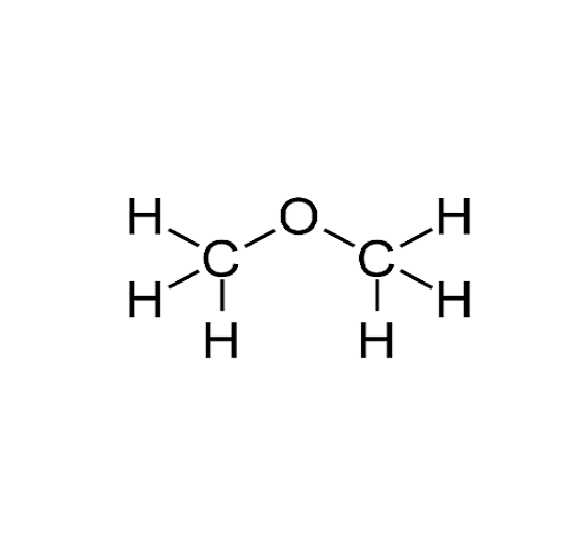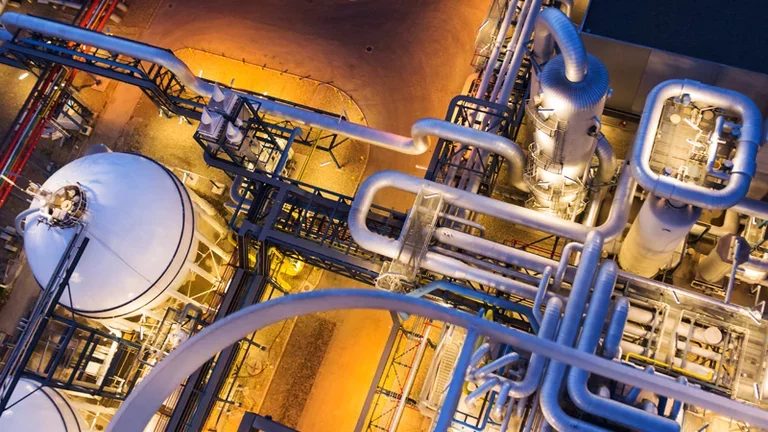
Dimethylether
- (CH3)2O
- CAS Number 115-10-6
- UN1033 (gas)
Click & drag to move the 3D molecule
Liquid / Gas Volumes
Calculate the volume or mass of a quantity of gas or liquid
Liquid Phase
At boiling point at 1.013 bar
Gas Phase
In standard conditions (1.013 bar, 15°C)
Physical Properties
Molecule phase diagram showing the transition phases between solid, liquid and gas as a function of temperature and pressure
-
- Molar mass 46.068 g/mol
- Content in dry air /
-
Critical Point
- Temperature 126.95 °C
- Pressure 53.7 bar
- Density 270.99 kg/m³
-
Triple Point
- Temperature -141.50 °C
- Pressure 3.05E-5 bar
Pressure 1.013 bar
| Latent heat of fusion (at melting point) | 107.168 kJ/kg |
| Melting point | - 141.49 °C |
Pressure 1.013 bar
| Boiling point | - 24.81 °C |
| Latent heat of vaporization (at boiling point) | 461.55 kJ/kg |
| Liquid density (at boiling point) | 735.2 kg/m3 |
| Compressibility factor Z | 9.7179E-1 |
| Cp/Cv ratio γ | 1.1746 |
| Gas density (at boiling point) | 2.362 kg/m3 |
| Gas density | 2.1145 kg/m3 |
| Gas/(liquid at boiling point) equivalent | 345.58 vol/vol |
| Heat capacity Cp | 1.4431 kJ/(kg.K) |
| Heat capacity Cv | 1.2285 kJ/(kg.K) |
| Specific volume | 4.729E-1 m3/kg |
| Thermal conductivity | 15.616 mW/(m.K) |
| Vapor pressure | 2.673 bar |
| Viscosity | 8.2865E-5 Po |
| Compressibility factor Z | 9.7735E-1 |
| Cp/Cv ratio γ | 1.164 |
| Gas density | 1.993 kg/m3 |
| Gas/(liquid at boiling point) equivalent | 366.65 vol/vol |
| Heat capacity Cp | 1.4615 kJ/(kg.K) |
| Heat capacity Cv | 1.2556 kJ/(kg.K) |
| Specific volume | 5.018E-1 m3/kg |
| Thermal conductivity | 16.999 mW/(m.K) |
| Vapor pressure | 4.392 bar |
| Viscosity | 8.7748E-5 Po |
| Compressibility factor Z | 9.8021E-1 |
| Cp/Cv ratio γ | 1.158 |
| Gas density | 1.9205 kg/m3 |
| Gas/(liquid at boiling point) equivalent | 380.49 vol/vol |
| Heat capacity Cp | 1.4787 kJ/(kg.K) |
| Heat capacity Cv | 1.2769 kJ/(kg.K) |
| Specific volume | 5.207E-1 m3/kg |
| Thermal conductivity | 17.958 mW/(m.K) |
| Vapor pressure | 5.928 bar |
| Viscosity | 9.0995E-5 Po |
Applications
Examples of uses of this molecule in Industry and Healthcare

Chemicals
Dimethylether is used as solvent in chemical and petrochemical industry.
Safety & Compatibility
GHS02
Flammable
GHS04
Gas under pressure
Autoignition Temperature, Flammability Limits & Flash Point
Europe (according to EN1839 for Limits and EN 14522 for autoignition temperature)
| Autoignition temperature (Chemsafe) | 240 °C |
| Lower flammability limit (IEC 80079-20-1) | 2.8 vol% |
| Upper flammability limit (IEC 80079-20-1) | 24.4 vol% |
US (according to ASTM E681 for Limits and ASTM E659 for autoignition temperature)
| Autoignition temperature (NFPA 325) | 350 °C |
| Lower flammability limit (NFPA 325) | 3.4 vol% |
| Upper flammability limit (NFPA 325) | 27 vol% |
Threshold of toxicity
| ILV-8h EU (at Patm and 293.15 K) | 1920 mg/m3 or 1000 ppm |
Odor
Slightly ethereal
Metals
| Aluminium | Satisfactory |
| Brass | Satisfactory |
| Monel | No data |
| Copper | No data |
| Ferritic Steel | Satisfactory |
| Stainless steel | Satisfactory |
| Zinc | No data |
| Titanium | No data |
Plastics
| Polytetrafluoroethylene | Satisfactory |
| Polychlorotrifluoroethylene | Satisfactory |
| Polyvinylidene fluoride | Satisfactory |
| Polyvinyl chloride |
Significant swelling
Not recommended
|
| Ethylene tetrafluoroethylene | No data |
| Polycarbonate | No data |
| Polyamide |
Significant swelling
Not recommended
|
| Polypropylene |
Significant swelling
Not recommended
|
Elastomers
| Butyl (isobutene- isoprene) rubber |
Significant swelling
Not recommended
|
| Nitrile rubber |
Significant swelling
Not recommended
|
| Chloroprene |
Significant swelling
Not recommended
|
| Chlorofluorocarbons | No data |
| Silicone | Satisfactory |
| Perfluoroelastomers |
Significant swelling
Not recommended
|
| Fluoroelastomers |
Significant swelling
Not recommended
|
| Neoprene | No data |
| Polyurethane |
Significant swelling
Not recommended
|
| Ethylene-Propylene |
Significant swelling
Not recommended
|
Lubricants
| Hydrocarbon based lubricant |
Significant loss of mass
Not recommended
|
| Fluorocarbon based lubricant |
Significant loss of mass
Not recommended
|
Materials compatibility
Learn More
More information
Dimethyl ether (DME), also known as methoxymethane, is the organic compound with the formula CH3OCH3, simplified to C2H6O. The simplest ether, it is a colorless gas that is a useful precursor to other organic compounds and an aerosol propellant and is being studied as a future energy option. It is an isomer of ethanol. Unlike other alkyl ethers, dimethyl ether resists autoxidation. Dimethyl ether is also relatively non-toxic, although it is highly flammable.